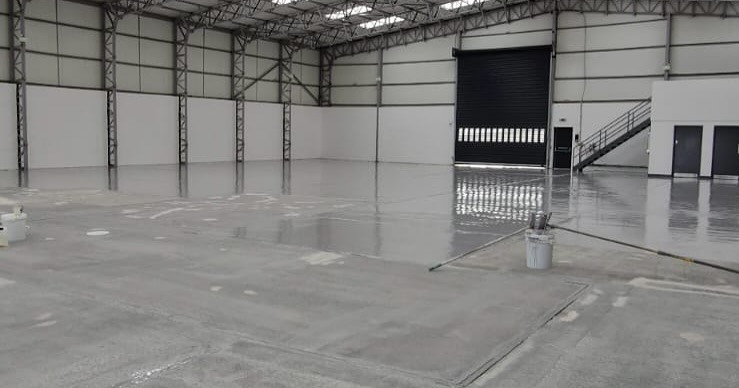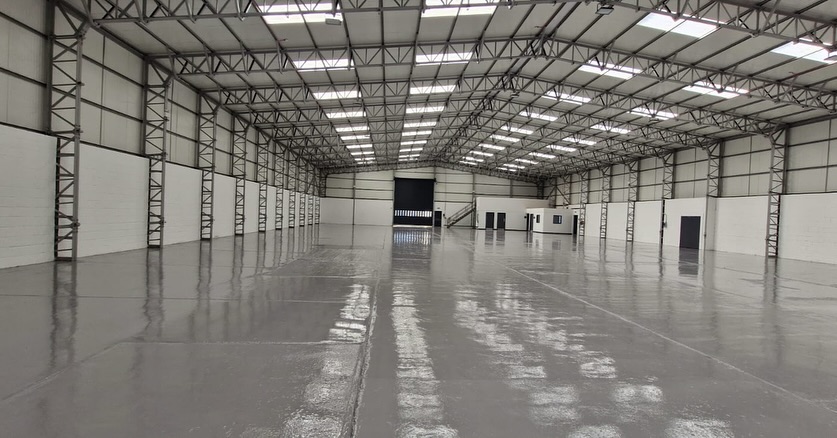Diamond grinding removes 0.5-3mm of concrete with controlled precision at £11-15 per m², ideal for surface preparation and levelling. Scabbling removes 3-10mm using pneumatic hammers at £11-15 per m², necessary for deep contamination removal but risking micro-fractures that require careful repair before coating application.
When surface contamination penetrates deep into concrete or severe deterioration requires aggressive removal, standard preparation methods prove insufficient. The choice between intensive grinding and concrete scabbling determines not just preparation speed but whether your substrate remains suitable for coating. After encountering hundreds of compromised concrete floors across London, we understand when aggressive removal justifies potential substrate damage.
Material Removal Capabilities
Our concrete grinding services progressively remove concrete using rotating diamond segments. Single-pass grinding removes 0.5-1mm, while multiple passes with aggressive diamonds can achieve 3-5mm total removal. The controlled cutting action preserves substrate integrity while exposing fresh concrete for coating adhesion.
Scabbling employs pneumatic or electric hammers with multiple tungsten carbide tips, pulverising concrete to depths of 3-10mm per pass. This percussive action fractures and removes deteriorated concrete, embedded contaminants, and failed coatings that grinding cannot efficiently address. However, the violent action creates micro-fractures extending 5-10mm below the scabbled surface.
| Removal Aspect | Diamond Grinding | Scabbling |
|---|---|---|
| Depth per Pass | 0.5-1mm | 3-10mm |
| Maximum Depth | 5mm practical | 50mm+ possible |
| Removal Rate | 50-100m²/hour | 20-40m²/hour |
| Profile Created | CSP 1-3 | CSP 7-9 |
| Substrate Damage | Minimal | Significant |
Surface Profile and Coating Readiness
Ground surfaces exhibit uniform scratch patterns ideal for coating application. The consistent CSP 1-3 profile provides excellent adhesion without excessive coating consumption. Self-levelling epoxies flow smoothly over ground surfaces, achieving designed thickness without pooling in depressions.
Scabbled surfaces resemble a lunar landscape with 5-10mm deep craters and ridges. This extreme CSP 7-9 profile requires extensive repair before coating application. Without proper levelling, coatings pool in depressions while high points remain unprotected, creating premature wear patterns and potential delamination.

Structural Impact and Micro-Fracturing
Grinding generates minimal vibration, preserving structural integrity even near joints, cracks, and edges. The rotating action doesn't create new fractures or widen existing cracks, maintaining substrate soundness throughout the preparation process.
Scabbling's percussive action transmits significant vibration through the slab, potentially damaging:
- Joints and crack repair materials within 2 metres
- Nearby equipment sensitive to vibration
- Substrate bond in multi-layer floor systems
- Underground services in suspended slabs
Micro-fractures from scabbling create weak planes that coating primers cannot fully penetrate. These hidden fractures often cause delamination 6-12 months after installation when thermal cycling or load stress activates the damage.
Expert Concrete Preparation Assessment
Unsure whether grinding or scabbling suits your contaminated concrete? Our specialists determine the optimal method to preserve substrate integrity.
Get Expert AssessmentProduction Rates and Efficiency
Modern ride-on grinders cover 50-100m² per hour depending on removal depth and concrete hardness. The continuous operation maintains steady progress without frequent stops for debris removal. Multi-head planetary grinders achieve superior flatness while maintaining production speed.
Scabbling machines process 20-40m² per hour for 5mm removal depth. The slower rate reflects frequent stops to clear debris, change worn tips, and allow operators rest from intense vibration. Hand-held scabblers for edges and details achieve only 5-10m² per hour, making edge work particularly time-consuming.
Appropriate Applications for Each Method
Use Diamond Grinding For:
- Standard surface preparation for coatings
- Removing laitance and surface contamination
- Levelling uneven concrete (up to 5mm)
- Creating specific CSP profiles for thin coatings
- Working near sensitive equipment or structures
- Projects requiring minimal substrate damage
Choose Scabbling When:
- Oil contamination penetrates beyond 5mm
- Removing deteriorated concrete (scaling, spalling)
- Eliminating thick failed coatings (>5mm)
- Exposing aggregate for overlay bonding
- Removing concrete to specific depths for repairs
- Substrate will receive thick overlay systems (>10mm)

Complete Cost Analysis
| Cost Factor | Diamond Grinding | Scabbling |
|---|---|---|
| Equipment Rate | £11-15 per m²0-400/day | £11-15 per m²0-500/day |
| Consumables per m² | £2-3 (diamonds) | £3-5 (tips) |
| Labour per m² | £11-15 | £11-15 |
| Surface Repair | Minimal | £11-15 per m² |
| Total per m² | £11-15 | £11-15 |
Scabbling's true cost includes mandatory surface repairs before coating application. Factor in epoxy mortar screeding at £11-15 per m². Contact us for a precise quote based on your specific project requirements to level the aggressive profile, potentially doubling total preparation costs.
Environmental and Safety Considerations
Grinding generates 85-95 dB of noise, manageable with standard hearing protection. Dust control via HEPA-filtered vacuum systems captures 95% of airborne particles. Operators work full shifts with appropriate PPE without excessive fatigue.
Scabbling produces 100-110 dB requiring double hearing protection and isolation of work areas. Dust generation exceeds grinding despite water suppression systems. Vibration exposure limits operators to 2-hour maximum continuous use, requiring crew rotation and increasing labour costs. Building occupants often cannot remain during scabbling operations.
Strategic Method Selection
For 90% of concrete preparation needs, diamond grinding provides sufficient removal depth while preserving substrate integrity. The controlled process, predictable results, and coating-ready finish make grinding the standard choice for industrial flooring preparation.
Reserve scabbling for situations where deep contamination or deterioration makes substrate replacement the only alternative. Accept that scabbled surfaces require extensive repair before coating application, adding time and cost to your project.
Consider combination approaches: scabble isolated areas of deep contamination, then grind the entire floor to uniform profile. This targeted strategy minimises substrate damage while addressing problem areas effectively.
For less aggressive preparation options, see our shot blasting comparison. For understanding finish requirements, consult our guide on concrete finish types and preparation needs.
Protect Your Concrete Substrate
Wrong preparation methods cause irreversible damage. Our experts specify the right removal depth and method to preserve your concrete while ensuring coating success.
Protect Your Investment